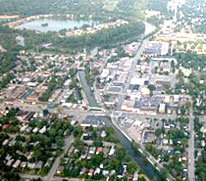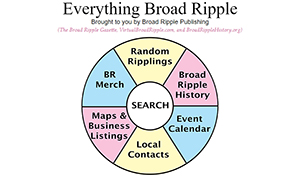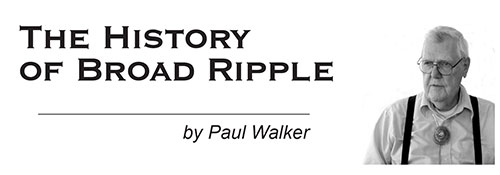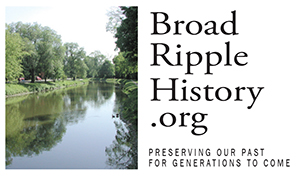
|
Broad Ripple Random Ripplings

The news from Broad Ripple
Brought to you by The Broad Ripple Gazette
(Delivering the news since 2004, every two weeks)

|
| Brought to you by: |

|

|

|

|

|

|
Converted from paper version of the Broad Ripple Gazette (v03n20)
The History of Broad Ripple - The King of Classic Cars in Broad Ripple - by Paul Walker
posted: Oct. 06, 2006

The King of Classic Cars in Broad Ripple
The Stutz pictured is a 1932-3 DV32 dual cowl phaeton. It or one like it sat in front of the Fletcher Trust Bank on Bellefontaine (now Guilford) during bankers' hours for all of 1934. I walked past it three times a day and never got over my deepest admiration for the thing. It was painted black over a dusty rose. This type of luxury car had no side windows. If it rained the chauffeur or owner snapped in canvas coverings where windows would have been. The side curtains, as they were called, had a pane of clear plastic-like material called isinglass inserted. To enter or exit the back seat of the machine, one had to raise the rear seat cowl and push it forward and fold the windshield down on it. All the big cars offered this type of body and sometimes the lesser cars. Business was so good during the twenties that most all manufacturers went all-out to make the most beautiful cars. The year 1929, time of the market crash, saw orders drop, but the car makers had already drawn up plans for super cars and could not foresee the depth of the depression coming.

image courtesy of Paul Walker
The car pictured was probably one of a kind for this marque. Prosperous buyers chose body styles from color catalogs available in the show rooms. Special-order cars had custom bodies made by any of a dozen or so builders, such as Derham (pictured), Brunn, Willoughby, etc. These same catalogs bring astronomical prices today from collectors. Fifty years ago a Lincoln catalog went for $50.00. I was into big cars then, as my dad sold funeral cars and took limousines in on trade. I drove a 1929 Lincoln 7-passenger and a 1934 Packard super 8 to Shortridge HS. One day I drove a 1929 black Auburn hearse to school. When I offered to drive a girl home in it she declined in a hurry! Wonder why?
Classic cars are closely defined today by the Classic Car Club of America. Certain requirements for inclusion in this rarefied circle include two or three of the following: high initial cost, a custom body, horsepower, luxury, speed, and technical uniqueness. They must have been built between 1925 and 1948. Older cars are antiques. The better cars made between 1948 and, say, 1970 are called milestones; other categories are hot rods, customs, muscle cars and special interest. Latter categories are usually mixed.
We watched a high-powered "classic car auction" on TV recently. Out of 200 cars that we saw auctioned off, there were only three classics; no antiques. All had souped-up engines and tons of chrome. Cars such as Corvettes went for over $100,000. Hence the word "classic" is abused.
The Stutz pictured met all of the seven requirements to be a Classic. It looked like a Duesenberg and it sounded like a Duesenberg. I remember a beautiful Duesie cruising down Meridian Street, its exhaust emitting a guttural rumble. In California, where I lived from 1953 to 1965, I had a friend, Tommy, who was a super mechanic. He had two Stutzes, a 1929 Model A Ford mail truck, and other cars. He put a Pierce Arrow transmission into one of his Stutzs to give him four speeds forward instead of three. The 1931 Stutz Super Bearcat he rode me around in was very fast and took the freeways at speed. No Cops! This car was a boat tail speedster, meaning it had only a seat up front. The rest of the car looked like half of an upside-down boat with the bow pointed aft. (Picture on request) He and I went to car meets where we rubbed shoulders with wealthy car owners. These groups were very democratic, and accepted Tommy and me as co-hobbyists.
end of part one
info@broadripplegazette.com

|

|

|
| Brought to you by: |

|

|

|
| Brought to you by: |

|

|

|


